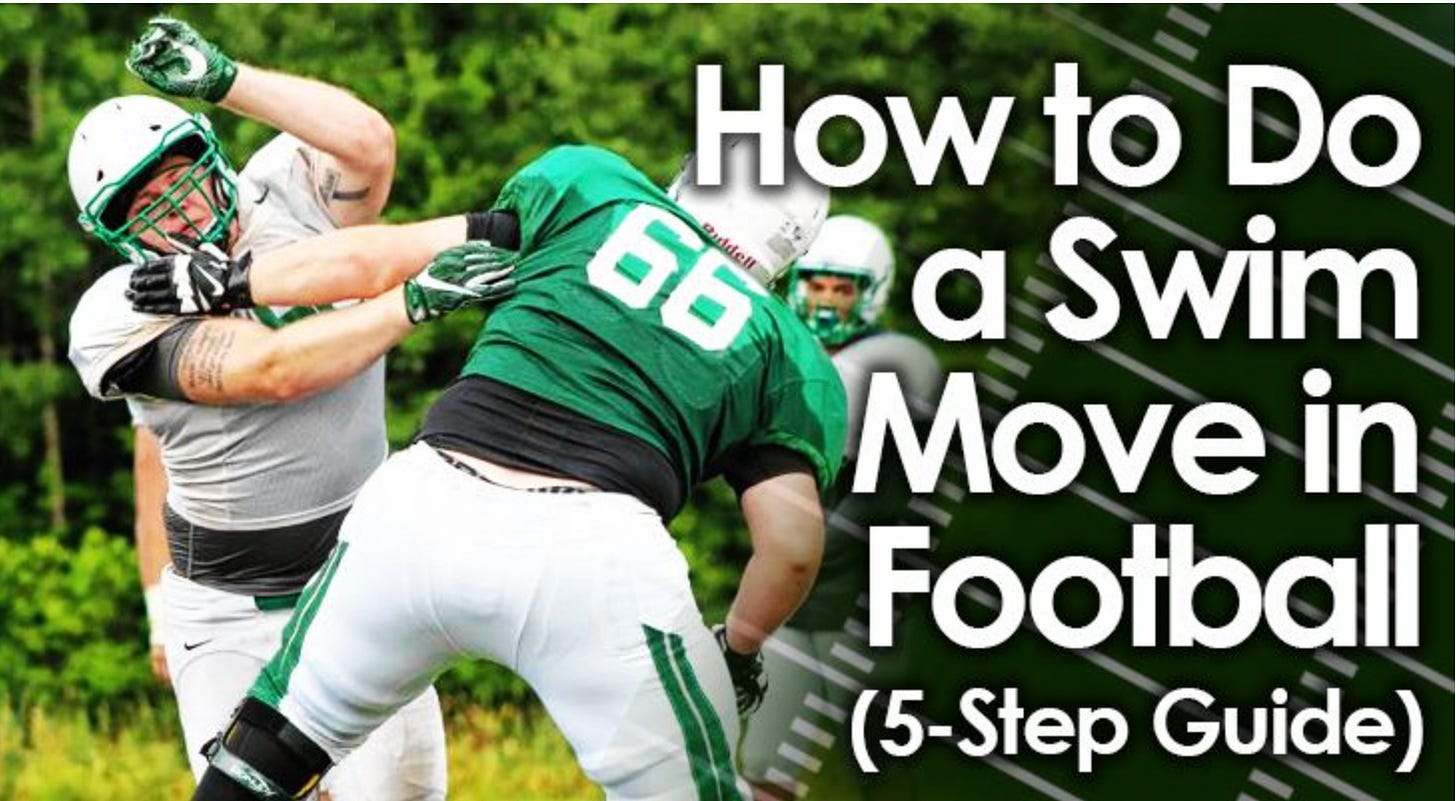Terminology: Bull Rush, Swim Technique, and Forearm Shiver
I fell while running in a local 5K recently and have struggled to lift my left arm ever since, so today, I had surgery to repair the torn supraspinatus and subscapularis tendons atop and at the front of the shoulder. I wrote and scheduled this Tidbit in advance and have a few others in the larder, but my ability to consistently produce Tidbits near-term is unclear. Let's hope for the best.
To prepare for my rotator cuff surgery, I wrote a Tidbit about how those with functioning shoulders use theirs, so I focused on terminology related to defensive line techniques. My third book, Hut! Hut! Hike!, covers the origins of football terminology, so if you like this Tidbit, you should like that book.
The first defensive line technique I reviewed was the Bull Rush. The text below is lifted directly from Hut! Hut! Hike!
Bull Rush
Beginning in the early 1890s, players spoke, and writers wrote about tough runners who ran the ball up the middle, shedding would-be tacklers through toughness and force of will. Teams like Yale were known to power the ball down the field with their ball carriers "bull rushing" through defenses. Jim Taylor, a Hall of Fame fullback with the Lombardi-era Packers, was among the last runners known to bull rush before the term fell from use in the 1970s.
Bull rush reemerged in the 1980s as the preferred term for the technique used by defensive linemen and linebackers who rushed through a pass blocker, overpowering him, and putting the blocker on his heels through power and leverage.
Swim Technique
Just as the bull rush was likely around long before the term arrived, the same is true for the swim technique. The swim technique can be used on an inside or outside rush. On the outside rush, the defender strikes the blocker's outside shoulder with the outside hand, as the inside arm swims over the blocker's outside shoulder (like a freestyle swim stroke) while simultaneously stepping with your inside leg past the blocker's outside leg.
According to a search of the newspaper archives, the swim technique was first mentioned in 1973 when describing Oklahoma's Leroy Selmon using it. That same year, Washington State coach Jim Sweeney described his defensive tackle, Greg Craighead, using the swim and other techniques expected of a pro, suggesting the method had been around for at least a while. Likewise, an article discussing defensive linemen on the Cincinnati Bengals' camp in 1974 describes their linemen who relied on finesse and the swim technique versus the strength-oriented bull rushers.
Forearm Shiver
The forearm shiver is a term that began life as the name for one technique before switching its meaning. The forearm shiver debuted in early 1930s newspapers, though the phrasing of some articles indicates it had been in use for at least a decade by then.
In the early days, the forearm shiver primarily described a technique used by defensive linemen to keep blockers away from their bodies. They did so by extending their arms and planting the heels of their hands on the blocker's upper chest or shoulder pads.
Most references to the forearm shiver meant the extended arm technique. However, a subset referred to offensive or defensive linemen striking the opponent with the forearm in an upward or lifting motion. Typically, the forearm shiver struck the opponent in the torso, and no one thought much about it unless the forearm continued upward to connect with the head. In other cases, players deliberately struck opponents in the head with their forearm and elbow, which gave the forearm shiver a bad name. The 1951 hit by Oklahoma State's Wilbank Smith on Drake's Johnny Bright brought considerable attention both to the forearm shiver and the treatment of Black players in college football.

In the 1960s, the lifting version of the forearm shiver overtook the extended arm version for the term's meaning, so much so that protective forearm pads became known as forearm shiver sleeves. I'm sure some coaches still refer to the extended arm technique as the shiver, and if they keep doing it long enough, the term will likely return to its original meaning, and they will be correct once more.
Click Support Football Archaeology for options to support this site beyond a free subscription.




Selfishly wishing you a speedy recovery so we continue to get tidbits in a timely manner. Tom
I missed the opportunity to let you know that I hope your injury heals quickly!